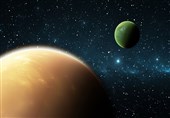Ancient Impact Forming Earth's Moon Was Likely A One-Two Punch
TEHRAN (Tasnim) – The gigantic impact that created the moon was actually a one-two punch, a new study suggests.
Scientists think that the moon, our planet's only natural satellite, was born in violence, coalescing from the material blasted into space after a Mars-size body named Theia slammed into the proto-Earth more than 4.4 billion years ago.
But there are some problems with the canonical collision scenario, which invokes a single catastrophic event, the authors of the new study said.
"The standard model for the moon requires a very slow collision, relatively speaking, and it creates a moon that is composed mostly of the impacting planet, not the proto-Earth, which is a major problem since the moon has an isotopic chemistry almost identical to Earth," lead author Erik Asphaug, a professor at the University of Arizona's Lunar and Planetary Laboratory (LPL), said in a statement.
Asphaug and his colleagues performed computer simulations of the long-ago giant impact and came up with what they believe to be a better fit: Theia and the proto-Earth crashed at faster speeds than previously envisioned, producing an initial "hit and run" collision that set the stage for a slower, accretionary encounter between the two battered bodies about 100,000 to 1 million years down the road.
"The double impact mixes things up much more than a single event, which could explain the isotopic similarity of Earth and moon, and also how the second, slow, merging collision would have happened in the first place," Asphaug said.
Hit-and-run collisions weren't restricted to the nascent Earth-moon system in those early days. Indeed, such bouncing smashups were probably about as common as accretionary mergers in the ancient inner solar system, the same research team reports in a second new study.
In the second paper, the scientists modeled giant impacts in the inner solar system, how those collisions affected planet formation and how the orbits of the involved objects evolved over time. They found that Earth likely acted as a sort of shield for Venus, taking the brunt of hit-and-run first impacts. Those initial collisions slowed the impactors down, setting the stage for accretionary mergers with Venus later.
"The prevailing idea has been that it doesn't really matter if planets collide and don't merge right away, because they are going to run into each other again at some point and merge then," Alexandre Emsenhuber, the lead author of the second study, said in the same statement.
"But that is not what we find," said Emsenhuber, who performed the research during a postdoctoral fellowship in Asphaug's lab at LPL and is now at Ludwig Maximilian University in Munich, Germany. "We find they end up more frequently becoming part of Venus, instead of returning back to Earth. It's easier to go from Earth to Venus than the other way around." (This is because Venus lies closer to the sun, whose powerful gravity draws objects in.)
The results suggest that the compositions of Earth and Venus may differ more than scientists had thought.
"You would think that Earth is made up more of material from the outer system because it is closer to the outer solar system than Venus," Asphaug said. "But actually, with Earth in this vanguard role, it makes it actually more likely for Venus to accrete outer solar system material."
Both new studies — the one led by Asphaug and the one led by Emsenhuber — were published online Thursday (Sept. 24) in The Planetary Science Journal.






